.jpg)
REFRACTIVE ERRORS IN CHILDREN
What is normal vision?
In order to better understand how certain problems can affect your child's vision, it is important to understand how normal vision occurs. For children with normal vision, the following sequence takes place:
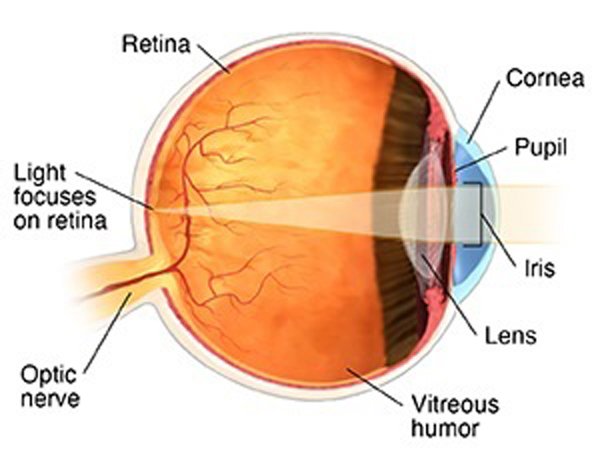
1. Light enters the eye through the cornea, the clear, dome-shaped surface that covers the front of the eye.
2. From the cornea, the light passes through the pupil. The amount of light passing through is regulated by the iris, or the colored part of your eye.
3. From there, the light then hits the lens, the transparent structure inside the eye that focuses light rays onto the retina.
4. Next, it passes through the vitreous humor, the clear, jelly-like substance that fills the center of the eye and helps to keep the eye round in shape.
5. Finally, it reaches the retina, the light-sensitive nerve layer that lines the back of the eye, where the image appears inverted.
6. The optic nerve carries signals of light, dark, and colors to the area of the brain (the visual cortex), which assembles the signals into images (our vision).
What are refractive errors?
The following are the most common refractive errors, all of which affect vision and may require corrective lenses for correction or improvement:


• Astigmatism. Astigmatism is a condition in which an abnormal curvature of the cornea can cause two focal points to fall in two different locations--making objects up close and at a distance appear blurry. Astigmatisms may cause eye strain and may be combined with nearsightedness or farsightedness. Astigmatism can start in childhood or in adulthood. Some symptoms include headache, eye strain, and/or fatigue. Eye rubbing, lack of interest in school, and difficulty in reading are often seen in children with astigmatism. Depending on the severity, eyeglasses or contact lenses may be required.
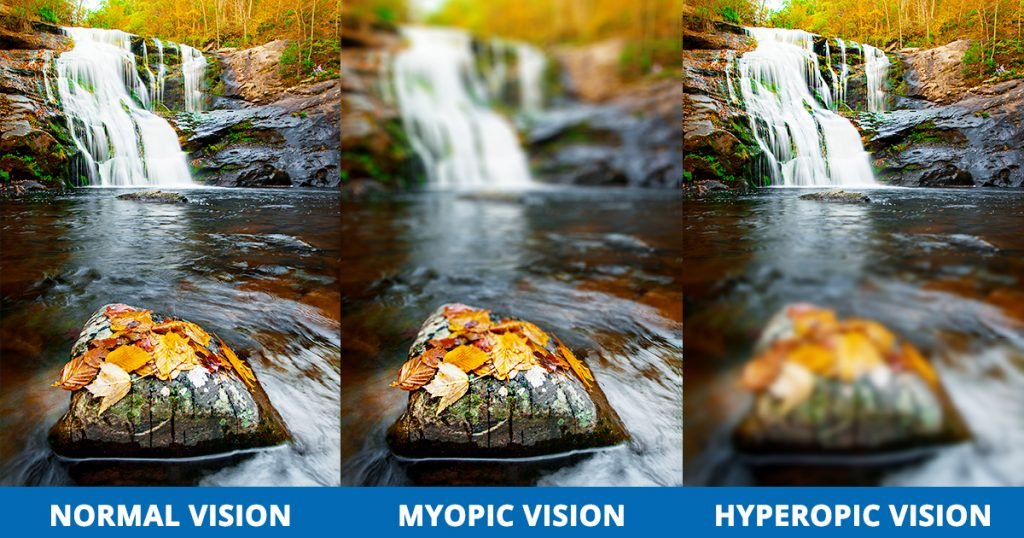
• Hyperopia.
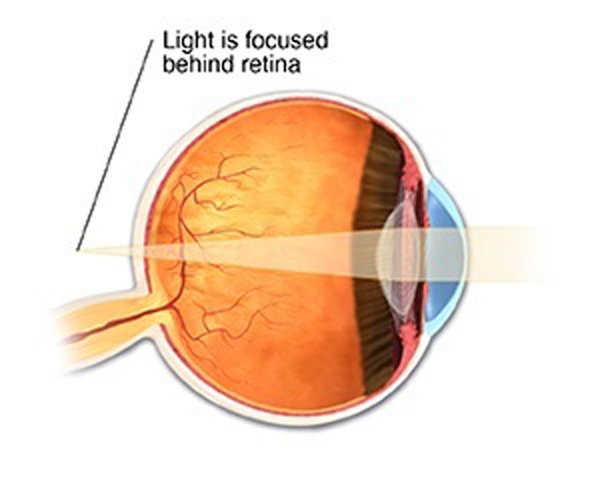
Commonly known as farsightedness, hyperopia is the refractive error in which an image of a distant object becomes focused behind the retina, either because the eyeball axis is too short, or because the refractive power of the eye is too weak. This condition makes close objects appear out of focus and may cause headaches, eye strain, and/or fatigue. Squinting, eye rubbing, lack of interest in school, and difficulty in reading are often seen in children with hyperopia.
• Myopia:
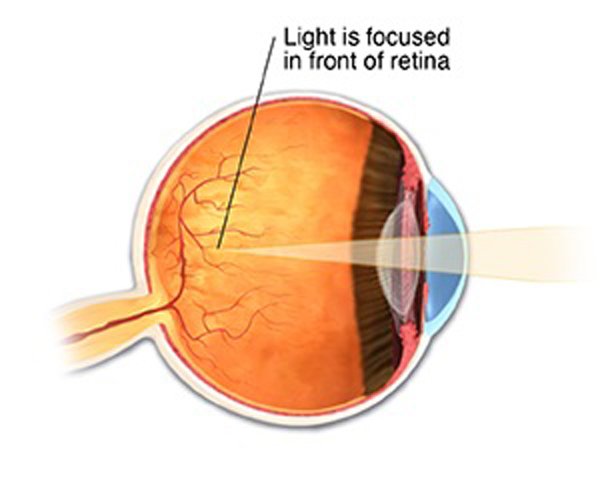
Commonly known as nearsightedness, myopia (the opposite of hyperopia) is a condition in which an image of a distant object becomes focused in front the retina, either because the eyeball axis is too long, or because the refractive power of the eye is too strong. Myopia is the most common refractive error requiring correction seen in children. This condition makes distant objects appear out of focus and may cause headaches and/or eye strain.
Eyeglasses or contact lenses may help to correct or improve myopia by adjusting the focusing power to the retina.
What causes refractive errors?
• Hereditary and genetic factors:
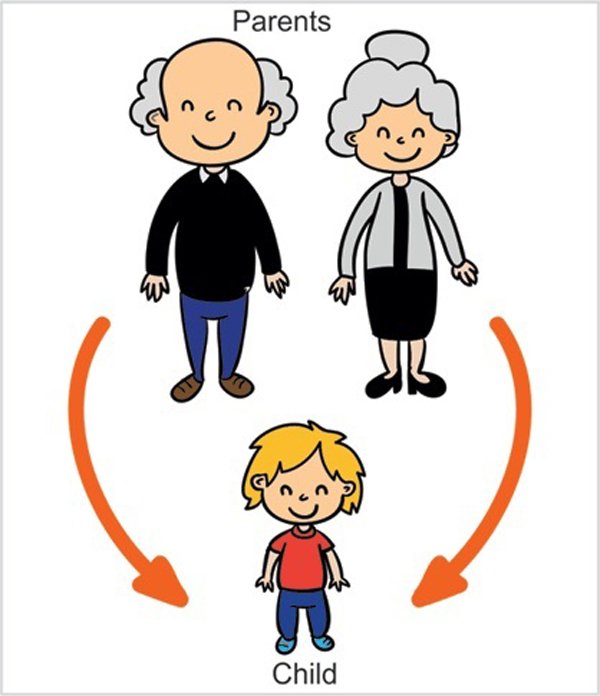
Refractive errors (myopia and hyperopia) have been found to cluster in families. A variety of inheritance patterns have been observed including dominant (one gene passed from a parent with a refractive error to a child), recessive (caused by two genes, one inherited from each parent who may or may not have a refractive error), and multifactorial (combination of genes and environment). Refractive errors are present in a number of genetic disorders, such as Marfan syndrome and Down syndrome.

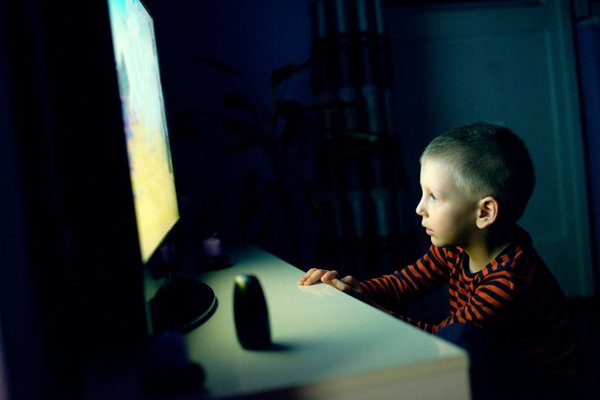
• Environmental factors:

Environmental factors such as reading in dim light or doing excessive amount of nearsighted work like watching TV especially from near distances, excessive use of mobiles and tablets may contribute to the problem.
Type II Diabetes:
Type II Diabetes in children can have refractive errors due to lens changes.
What are the Symptoms or Warning Signs of a Refractive Error?
It can be difficult for young children to express to us when something is wrong, so a regular evaluation by an eye doctor is so important. However, there may be some symptoms you can look for in your child. The following is a list of some common symptoms or warning signs of refractive errors:
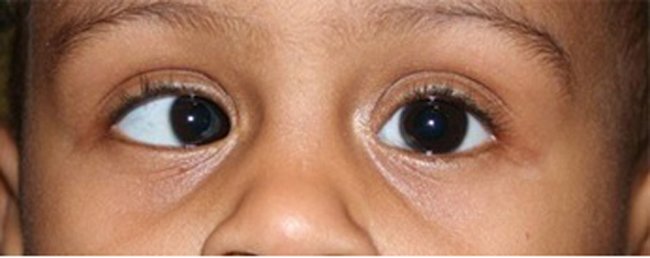


• Squinting
• Stating they see a “halo” or “glare” around bright lights
• Double vision
• Hazy vision
• Headaches
• Sore or tired eyes
• Difficulty with eye focus when reading or at a computer
If your child complains of the above symptoms or you note them in your child, make an appointment with your pediatrician or ophthalmologist for an evaluation.
What Is a Refraction Test for Pediatric Patients?
A refractive test is typically included in a pediatric eye exam. These tests evaluate how clearly young children can see by measuring how much light hits their retina—the nerve layer at the back of the eye. The test results can help determine if a patient needs an eyeglasses prescription or another type of vision correction.
There are a few different types of refraction tests that your child's eye doctor may perform, including:
• A computerized test that uses a machine to determine how much light is moving through your child's eyes.
• A manual light reflex test where the doctor shines light into each eye and measures how much light is reflected by the retina.
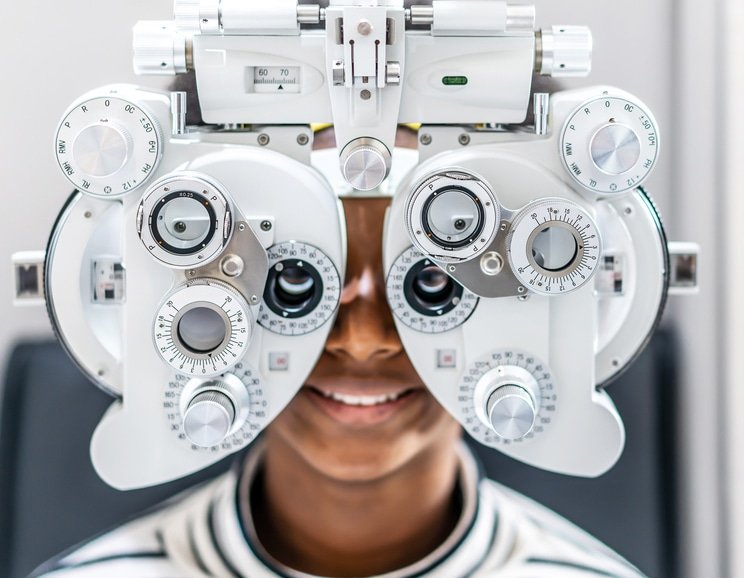
• A phoropter test, in which your child's face is positioned against a mask-like device called a phoropter. They will be asked to look through the device at an eye chart 20 feet away and identify the pictures or letters on it if they are able. The idea is to find the smallest row of items that the child can see.
Dilatation is commonly used in these tests because children tend to focus in on nearby visuals when they are supposed to be looking far away during examination. Optometrists will often perform a cycloplegic refraction, temporally relaxing the focus muscles in the eye with eye drops. This allows the eye doctor to measure farsightedness and get a true measure of refractive errors.
Refractive errors management:
Ways to correct your vision if you have refractive errors include:
• wearing glasses – a simple and safe way to correct your vision
• wearing contact lenses – these are worn directly on the eye
• having laser surgery – using a laser beam to change the shape of your cornea.
How To Choose Children’s Eyeglasses:
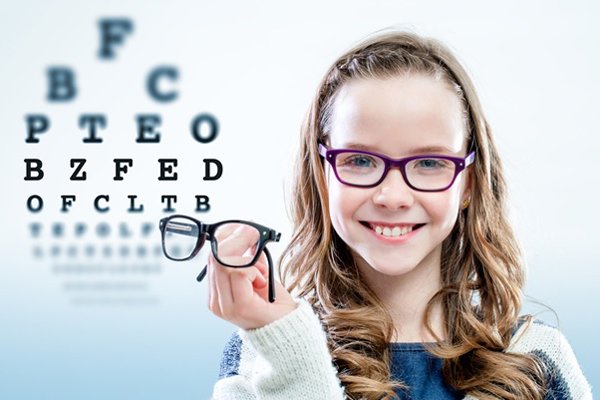

Choosing a first pair of glasses for a child can be challenging since there’s more to consider than style alone. The key variables to remember are frames that fit properly and comfortably, and durable and scratch-resistant lenses. Make these the top priorities when you shop—if your child’s frames are broken or uncomfortable, that means time spent not wearing them.
What are the safest, most comfortable, and durable eyewear options for children? Explore our answers to questions you should ask when purchasing glasses for your children.
What Are The Best Eyeglass Frames Materials For Kids?
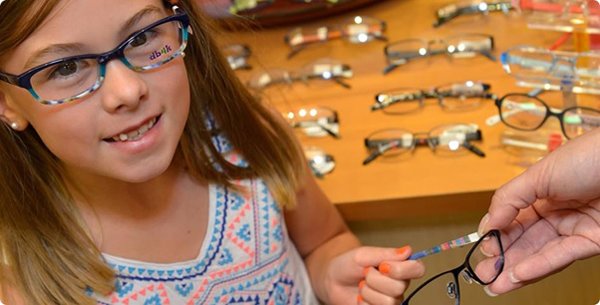
Plastic frames were once the preferred type for children because of their durability, until metals became more durable, and other materials like rubber became available. Whether you’re looking for children’s designer eyeglasses, or something a little more budget friendly, you’ll find plenty of lightweight, stylish frames in a variety of colors. Memory metal like the bendable material EasyTwist uses is perfect for kid’s glasses, as it’s virtually unbreakable and can withstand rough treatment without warping. These frames are ideal for the child who occasionally mishandles their glasses or tends to fall asleep while wearing them.
But plastic is still a common choice in kids’ eyewear. Plastic frames are most often used in sports and high-performance eyewear, so they’re a perfect option for active kids.
What Are The Best Lenses For Kids?
The best eyeglass lens types for children will vary from child to child, but it's best to go with strong, durable lenses.

Polycarbonate is one of the most durable lens materials available, ideal for an active child. This lens material resists impacts, so during the inevitable childhood mishaps, polycarbonate lenses won't shatter as plastic or glass lenses do.
If your child wears prescription glasses, we strongly suggest polycarbonate lenses for their safety. These lenses are impact-resistant, which will help protect your child from injuries if he or she has an accident while wearing eyeglasses.
Polycarbonate lenses also provide 100% protection from UV rays—there's no need to purchase a special UV coating for them. UV rays can damage the eye just as they do the skin, so it's important for your child to wear eyeglasses that will protect their eyes from UV rays. And polycarbonate lenses are lighter weight and thinner than plastic or glass lenses, which will help your child adjust to wearing eyeglasses.
All polycarbonate and hi-index lenses at FramesDirect offer 100% UVA/UVB protection.
Other Lens Options For Children’s Eyeglasses:
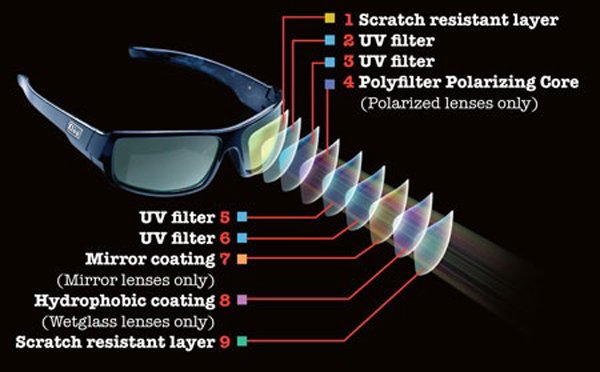
Lenses come with several other options, and some are ideal in children’s eyewear. Here are a few to consider:
Scratch-Resistant Coating:
A scratch-resistant coating is imperative in your child’s eyeglass lenses. All lenses are prone to scratching, but scratch-resistant lenses will better withstand rough treatment by a child.
Anti-Reflective Coating:
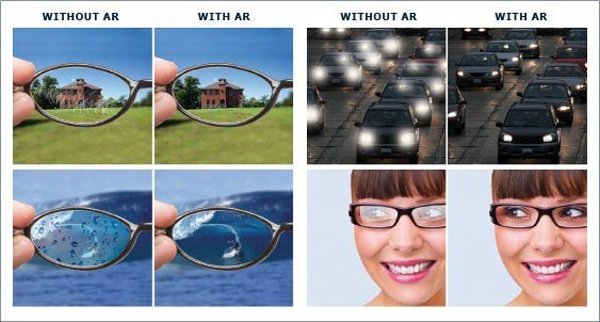
Bright light reflecting on eyeglasses can be hard your child’s eyes; an anti-reflective lens coating will reflect light away from the eyes and reduce glare.
Lens Tint and Color:
While most lenses are clear, you can also choose from a variety of tints and lens colors. Yellow lenses, which may offer some protection from the harmful blue light emitted by digital screens, are available in children’s eyeglasses.Some brands offer their own proprietary lenses in children’s eyewear.
What Kinds Of Nose Pads Are Offered On Children’s Eyewear?
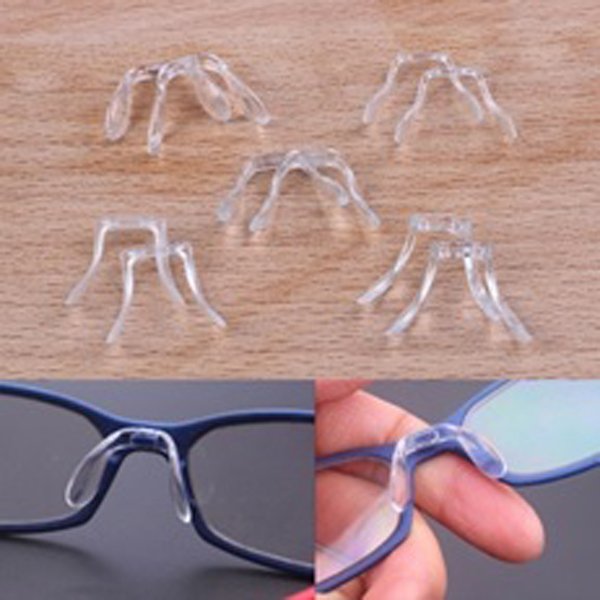
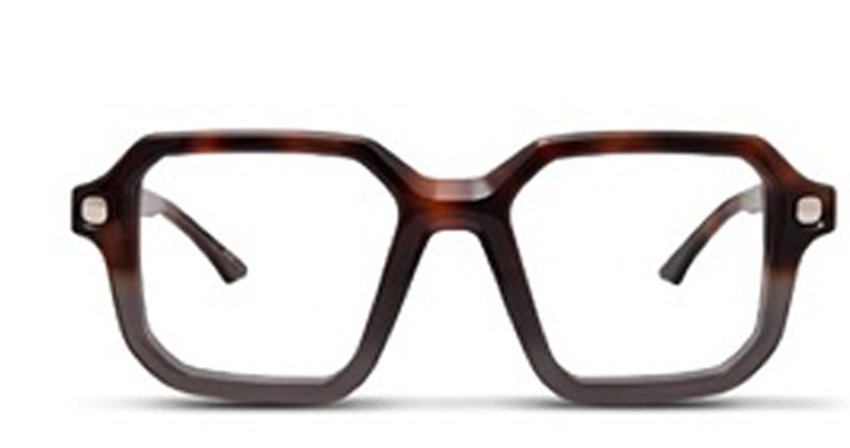
Frames typically come with one of two options in nose pads—adjustable or integrated pads. The adjustable style usually includes non-slip pads. This benefits the child in two ways: The nose pad will adjust to fit comfortably and securely, and the non-slip pad will keep the eyeglasses in place. Integrated nose pads are molded into the frame, with no separate parts or pieces. The benefit of integrated pads is durability—because, let’s face it, kids can be rough on their eyewear.
Will Eyeglasses Improve My Child’s Vision?
Wearing glasses can improve the visual clarity your child enjoys, but it’s due to the vision correction offered by the lenses rather than any physical change to their eyes.
Top Nine Ways to Improve Vision in children
1. SPENDING TIME OUTDOORS:

A lot of people are taken aback when they read about this particular home remedy, because it doesn’t make use of any direct ingredient or food product or medicine. It is a simple exercise, which asks you to go outside in the lap of nature and expose your eyes to as much greenery as possible.
The color green has been proven to have a soothing and cooling effect on the eye which can provide relief to your eyes, and prevent it from taking on too much strain. It is also a welcome break for your eyes, which has become accustomed to screens and artificial light.
a) Sunlight:

The sun’s visible light is significantly brighter than the lighting in almost any indoor setting, which may play a major role in controlling myopia.
Studies have shown that when sunlight comes in contact with the retina, it causes the release of dopamine into the eye. This may prevent the eye from elongating. Preventing the eye from growing too long is the main goal of myopia management.
What is certain: children who spend at least 2-3 hours playing outdoors in the sunshine progress less rapidly than children who spend almost all their time indoors.
b) Long-Distance Focusing:
It is well established that prolonged near activities like reading and screen time contribute to myopia onset and progression. It’s no surprise that studies now show COVID-19 confinement may have caused higher rates of myopia in children as well.

Spending time outdoors, on the other hand, encourages your child to focus on distant objects like trees, basketball hoops, a ball flying through the air— anything that’s more than an arm’s length away.
c) Vitamin D:
Vitamin D helps smooth muscle tissue around the eye’s crystalline lens allowing it to function properly.
This smooth muscle helps focus light on the retina, and may also help maintain the proper eye shape and length between the lens and the retina, which can become distorted as a child’s eyes grow with every passing year.
Moreover, the sun’s invisible UVB light triggers Vitamin D production. Some studies have found that nearsighted individuals have lower levels of Vitamin D than those with normal vision. However, more research is needed to solidify this claim, as only small-scale studies have been performed.

The recommended time for daily outdoor play is at least 2 hours for children over the age of 6. Be sure to send your child outside with a water bottle, sun hat, sunglasses, and sunscreen.
2) STRETCHING AND BREATHING EXERCISE:

Even though stretching and breathing exercise might not be a topical treatment for your eyeballs, it is nonetheless an overall exercise which helps you keep your body in perfect shape, health-wise. Along with eye exercises, if you can practice stretching and breathing exercise on a daily basis, then you core strength will increase, along with your core energy, which can help heal your eyesight.
There are also specific stretching and breathing exercise which focus exclusively on your eyes, and can help you regain your vision if you have been a victim of cataract or myopia.
3) EAT FOR YOUR EYES:

Eating carrots is good for your vision. Although it may sound cliché, it’s not entirely wrong. Carrots are rich in vitamin A, an essential nutrient for vision. However, vitamin A isn’t the only vitamin that promotes healthy eye function. Make sure that you include foods rich in vitamin C, vitamin E, copper, and zinc to your diet.
As you get older, macular degeneration can become your biggest challenge. Antioxidants can help reduce macular degeneration. As such, eat foods such as eggs, pumpkins, carrots, dark leafy greens, and sweet potatoes.
Fish is also great for your eyes. Cold water fish such as mackerel, wild salmon, and cod are rich in DHA, a fatty acid that strengthens cell membranes, including those in your eyes.

4. EXERCISE FOR YOUR EYES:
Since eyes have muscles, they could use some exercises to remain in good shape. Eye exercises are great when done in the morning, when your eyes feel tired and before retiring to bed. If you’re consistent for a month, you may start noticing a difference.
Begin by warming your eyes for five seconds with warm palms. Do it three times. Rolling your eyes isn’t just an expression of annoyance, it can help your eye muscles too. Look up and circle your eyes about ten times in both directions.
To sharpen your focus, hold a pen at arm’s length and focus on it. Move the pen closer slowly until it’s about six inches from your nose. Redo this process ten times.
To access the exercise programme designed by Dr. SURESH EYE HOSPITAL CLICK HERE -
10 EYE EXERCISES FOR HEALTHY EYES
5. FULL BODY EXERCISE FOR VISION - OUTDOOR GAMES:
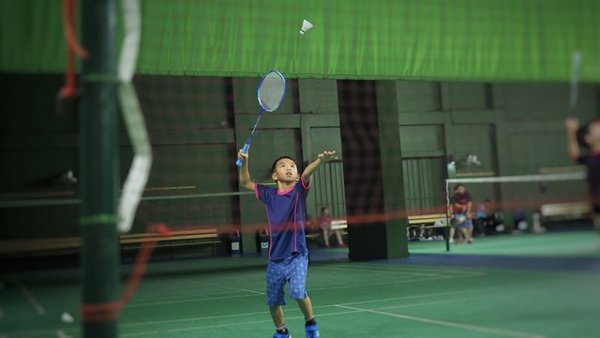
Playing games like shuttle cock where your eyes oscillate between infinity (beyond 6 meters) and near vision is good for children.
6. SCREEN TIME:

Closing your eyes for just a few minutes is helpful. You can do this once an hour or many times when you’re hard at work. And if your job involves sitting in front of a computer or reading, closing your eyes can be refreshing. As simple as it sounds, this exercise can protect your eyes from over exertion or fatigue.
Current Screen Time Guidelines:
Children under age 2 should have no screen time.
Limit screen time to 1 to 2 hours a day for children over age 2.
Despite what ads may say, videos that are aimed at very young children do not improve their development.
How to Decrease Screen Time:

Cutting down to 2 hours a day can be hard for some children because TV may be such a large part of their daily routines. But you can help your children by telling them how sedentary activities affect their overall health. Talk to them about things they can do to be healthier.
To decrease screen time:
• Remove the TV or computer from your child's bedroom.
• Do not allow TV watching during meals or homework.
• Do not let your child eat while watching TV or using the computer.
• Do not leave the TV on for background noise. Turn on the radio instead, or have no background noise.
• Decide which programs to watch ahead of time. Turn off the TV when those programs are over.
• Suggest other activities, such as family board games, puzzles, or going for a walk.
• Keep a record of how much time is spent in front of a screen. Try to spend the same amount of time being active.
• Be a good role model as a parent. Decrease your own screen time to 2 hours a day.
• If it is hard not having the TV on, try using a sleep function so it turns off automatically.
• Challenge your family to go 1 week without watching TV or doing other screen-time activities. Find things to do with your time that get you moving and burning energy.
7. GET ENOUGH SLEEP:
Resting your eyes for a couple of minutes isn’t enough. Your body requires regular, restful sleep. Any doctor will inform you about the importance of sleep for your health and wellbeing. When your body gets enough rest, your eyes become renewed. If you engage in intense visual activity such as working on a computer or reading a book, short breaks go a long way in helping your eyes, as it gives them a chance to rest.
8. CREATE EYE - FRIENDLY SURROUNDING:
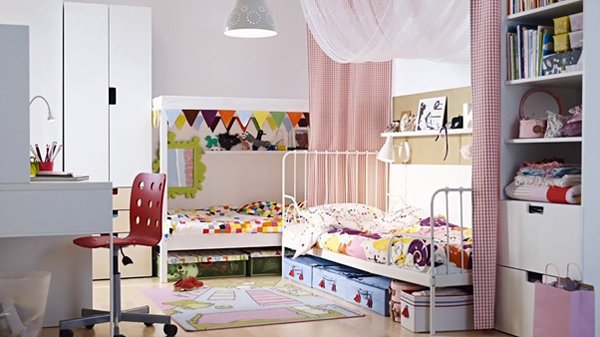
Plenty of things that surround us everyday can be bad for the eyes. For instance, sitting for long periods of time in front of a computer, getting swimming pool chlorine water in your eyes, using dim lighting when reading, and fluorescent lights can degrade your vision. Look out for these conditions and do all you can to reduce exposing your eyes to them.
9. HAVE REGULAR EYE EXAMS:
Most people wait until they experience eyesight problems to get eye exams. Sometimes, that can be too late. Getting eye exams early can help diagnose problems before they become severe. In fact, most vision defects can be corrected when detected early.
Regular vision exams can help by:
• Adjusting prescriptions for corrective lenses:
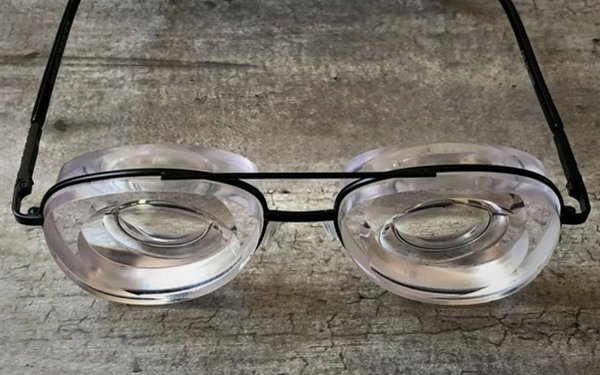
Vision changes with time and the eyeglasses that were once the best diopter might be damaging your eyes now.
• Check alignment:
Sometimes turned or crossed eyes can cause strain on eye muscles. Your eye doctor can help diagnose this issue early to avoid causing further damage to your eyes.
• Eye tone:
Eye tone changes with age and a corrective lens can bridge any defects.
• Retina exam:
Blood vessels present in the retina can be signs of diabetes. Eye exams can reveal more health issues beyond vision.
Questions and answer:
1. How is the glass power measured?
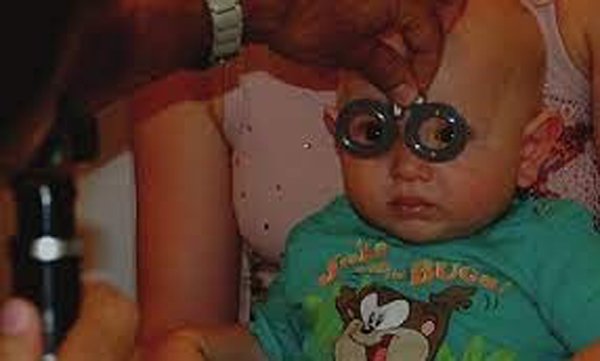
The glasses are prescribed by your ophthalmologist or optometrist after carefully checking and rechecking the amount of refractive error both subjectively and objectively. The objective testing by retinoscopy is done twice, once before putting eye drops to relax the focusing muscles and again after the effect of the eye drops is obtained. In very small and uncooperative kids only objective testing is possible but you should not be worried about its accuracy since this is done by professionals with years of experience.
14 Also it should be kept in mind that the eye drops which are used to accurately measure the power of the eyes will cause a little blurring of vision for some hours after which it will be back to normal, so do not be scared.
On rare occasions we may need to use stronger drops to get the most accurate glass power. These eye drops are called Atropine eye drops. There is a specfic method in which these drops are to be put in the child’s eyes and will be explained in detail by your doctor / optometrist before prescribing them to you. While putting the drops the puncta (small opening on the lower eyelid near the inner side of the lid) should be closed so that the drops are not absorbed into the body through this opening, some sensitive children may get fever and body rash if this happens. Again like other medicaions there will be a little blurring of vision after using these drops and this will last for some days. These drops are to be put 2 times a day for 3 days. On the fourth day the test has to be performed in the clinic.
2. What kind of glasses should you make?
There are a number of options available now-a-days.
These options will be best explained by our optician. But you should keep in mind that no glass is scratch proof so your glasses should be handled with care.
3. Can carrots prevent/ reverse/ reduce refractive error?
This is an age old concept but sadly not true. Carrots have a high content of Vitamin A in them which is required for something called as dark adaptation and other chemical processes in the eye. But it has no impact on reducing the glass power.
However, good nutrition is always good for any child for adequate overall development and for building up natural immunity against the ill effects of pollution and infections. A child’s plate should be colourful and should contain all colours of vegetables and fruits.
4. Can the power of glasses caused by refractive error wear off on its own?
The power may have fluctuations and may reduce. Very rarely it may wear off on its own unless the child has a small amount of hyperopia which tends to reduce with age. The power changes and so regular check-up is recommended.
5. What are the treatment options available for Myopia, hyperopia and astigmatism?
The most common and important treatment for nearsightedness is wearing eye glasses. Contact lenses can be used once the child is old enough to wear/remove and take care of the lenses by him/herself.
Myopia often increases progressively during adolescence. However, Myopia tends to stabilize after the age of twenty in most cases.
Hyperopia on the other hand tends to decrease as the child’s eye grows with age.
Astigmatism on the other hand may not follow a set trend of increase or decrease with age and time, however it can definitely change – increase or decrease.
The eyeglass or contact lens prescription may need to be adjusted periodically in all the refractive errors; hence a regular follow up as per instructions is necessary.
A number of laser/surgical procedures are used to correct Refractive Errors. However, these are 13 not recommended for children under the age of 18-20 years because their eyes are still growing upto this age.
.jpg)
.jpg)
{{r.reply}}
Your comment was submitted for review. It will start display once it was approved by Admin
Comments